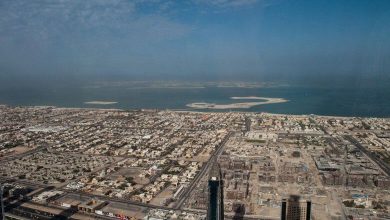
Kuwait is situated in the northwest corner of the Persian Gulf, between coordinates 28°30′N and 30°06′N and 46°30′E and 49°00′E. It shares borders to the north and west with Iraq and to the south and southwest with Saudi Arabia.
The Persian Gulf laps at Kuwait’s western shores. This strategic location has given Kuwait commercial significance as a natural outlet for the northwest corner of the Arab Peninsula.
Kuwait, a tiny emirate wedged between Iraq and Saudi Arabia, occupies a stretch of the Arabian Desert, one of the driest and least habitable regions on the planet. However, a deep harbor on the Persian Gulf, Kuwait Bay, is located on its shore.
Bedouins from the interior established a trade station there in the 18th century. Kuwait is an Arabic shortening of the Hindustani word kt (meaning “fort”).

Foreign trade has been crucial to the emirate’s prosperity ever since the l ab dynasty, the country’s reigning family, formally founded a sheikhdom in 1756. Kuwait City was once a modest fort, but with time passing by and the accumulation of money, it expanded into the contemporary metropolis that it is today, complete with skyscrapers, residential complexes, and mosques. Most Kuwaitis live in the capital city, making it one of the most urbanized nations.
Kuwait, which is slightly bigger than the state of Hawaii in the United States, is located between Iraq to the west and the north, the Persian Gulf to the east, and Saudi Arabia to the south.
Except for the lush spots in the southeast and along the coast, including the oasis of Al-Jahr at the western end of Kuwait Bay, Kuwait is primarily a desert. The two biggest of Kuwait’s offshore islands, Bbiyn and Al-Warbah, are deserted. Faylakah Island, at the mouth of Kuwait Bay, has been inhabited since ancient times.
Until a formal border was settled in 1969, Kuwait and Saudi Arabia enjoyed a neutral zone along the Gulf of 2,200 square miles (5,700 square kilometers). While the two nations now each control half of the land (the Neutral or Partitioned Zone), they continue to split the oil profits evenly. The border with Saudi Arabia is clear, but the one with Iraq isn’t.

Landscape of Kuwait
Kuwait’s landscape is mostly level or gradually sloping, with only a few small hills and shallow valleys here and there. The eastern coast is at sea level, whereas the westernmost mountain, Al-Shiqya, rises 951 feet (290 meters) above sea level. One of the most prominent physical characteristics is the 475-foot-tall (145-meter-tall) Al-Zawr Escarpment, which runs along the northwest coast of Kuwait Bay.
Large regions of salt marsh have emerged further along the coast. Desert basins may be found over the northern, western, and central parts of Kuwait; these basins have historically served as vital watering areas and refuges for the Bedouin’s camel herds.
Neither lakes nor rivers run year-round in Kuwait; hence neither type of surface water is present in the country. Wadis are small, sporadic waterways that often dry up in the interior of the desert. Most rainwater evaporates into thin air before it can be absorbed by the ground.

Natural soils are quite rare in Kuwait. Those that do exist have a very low organic matter content, making them unsuitable for agricultural use. High levels of salinity can be found in eolian soils and other sedimentary deposits, especially in basins and other areas where residual water accumulates.
The solid surface layer of the desert was widely destroyed during the Persian Gulf War, which led to a growth in wind-borne sand and the construction of bigger and more frequent sand dunes throughout the nation.
Climate of Kuwait
Kuwait’s climate is characterized by arid desert conditions, with extremely warm summers and brief, mild winters. Wind patterns in June and July cause sandstorms, and springtime thunderstorms are prevalent. In Kuwait, temperatures range from a high of 112 degrees Fahrenheit (44.5 degrees Celsius) in August to a low of 45 degrees Fahrenheit (7 degrees Celsius) in January.
The balmy waters of the Persian Gulf of Mexico moderate the arid heat along the shore. From about the middle of March until the end of April, the desert can become verdant if there has been enough precipitation. However, during the dry season (April–September), the heat is unbearable, with average daily highs of 111°F (44°C) and occasional peak highs of 130°F (54°C).

The winters are milder (occasional frost is possible inland but never near the ocean). Cloudbursts can deliver more than 2 inches (50 mm) of rain in a single day, but annual rainfall averages just 1 to 7 inches (25 to 180 mm), mostly between October and April.
The northwesterly breezes blow cold in the winter and spring but may get rather warm in the summer. Breezes from the southeast tend to be hot and humid from July to October, while breezes from the south tend to be hot and dry from March to May. The shaml, a typical northwesterly wind between June and July, is responsible for the spectacular sandstorms that occur then.
Flora and fauna of Kuwait
Scrub and low shrubs (and temporary grass in the spring) are the only types of vegetation found everywhere in Kuwait, with the exception of the city’s new green belt and a few desert oases like Al-Jahr. In the coastal marshes, salt-loving halophytes thrive.
Due to the severe weather, only gazelles, foxes, and civets are able to survive. Reptiles range from the common monitor and vegetarian dab lizards (Uromastix spinipes) to the extremely uncommon and poisonous sand viper (Cerastes vipera).

The native flora of Kuwait is a precious part of the country’s history. Plants can tolerate high temperatures and other severe situations because they have evolved to them. The strong strain from grazing, fuel collecting, and other activities led to their extinction. It is possible, however, to identify four primary ecosystems:
Some perennial bushes of medicinal potential thrive in the sand-dune ecology. Annual grass is the other major plant community.
Along the coasts of Kuwait, you’ll find many of salt-marshes and salty depressions. Since this is such a marine-dominated ecosystem, the flora must have more than simply salt tolerance. There is a distinct zonation of plants typical of salt marshes.
Buggy clamps of perennial desert grass dominate this barren landscape. In contrast, many purple and blue blooms flourish in low depressions that collect infrequent rainfall.

Many different kinds of insects, animals, and birds may be found in Kuwait. Butterflies are the most beautiful of all the many kinds of insects. The ideal time to observe the many stunning kinds of animals here is in the spring. Some 38 species of snakes, lizards, geckos, and other reptiles have been documented in Kuwait.
In addition, there are 50 different types of animals, many of which are critically endangered. Hedgehogs, wolves, wild cats, gazelles, and so on are only some of the more regular wildlife sightings. There have been sightings of around 280 different bird species here. They are mostly migratory birds, by the way.



